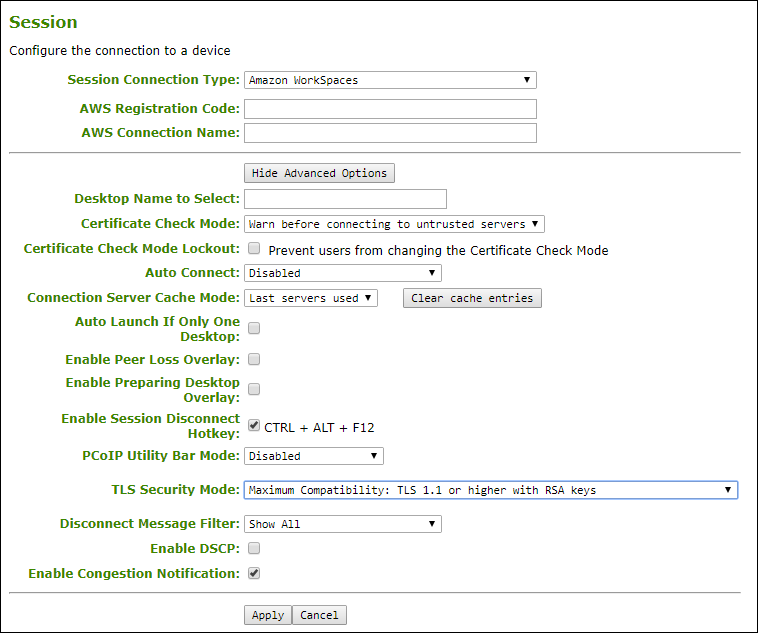AWI: Amazon WorkSpaces¶
Select the Amazon WorkSpaces session connection type from the Configuration > Session page to configure the client to connect directly to your Amazon WorkSpaces desktop through multi-factor authentication when connecting with PCoIP Zero Clients on firmware 6.0 or newer. This connection type removes the need to deploy and manage the PCoIP Connection Manager for Amazon WorkSpaces in order to connect PCoIP Zero Clients to Amazon WorkSpaces.
Security
The connection manager determines the security requirements. Amazon WorkSpaces session type uses an Amazon connection manager which requires multi-factor authentication when connecting to Amazon WorkSpaces.

AWI Session Connection type – Amazon WorkSpaces
The following parameters can be found in the AWI Session tab when the Amazon WorkSpaces connection type is selected with the advanced tab showing.
AWI Amazon WorkSpaces
| Parameter | Description |
|---|---|
| AWS Registration Code | Enter the registration code from the invitation email sent after creating your Amazon WorkSpace. |
| AWS Connection Name | Enter a name for this registered Amazon WorkSpace instance. |
| Desktop Name to Select | Enter the desktop name used by the client when starting a session. This field is case-insensitive. |
| Certificate Check Mode | Select the level of verification performed on the certificate presented by the connection server:
|
| Certificate Check Mode Lockout | When enabled, prevents users from changing the Certificate Check Mode settings from the OSD. |
| Auto Connect | This field determines the client’s auto connect behavior after startup:
After enabling Auto Connect, the client must be power-cycled for the change to take effect. |
| Connection Server Cache Mode | This field determines which Amazon Workspaces a user can select from the connection drop-down menu on the OSD Connect page.
|
| Auto Launch If Only One Desktop | When enabled, users are automatically connected to a provisioned desktop after user credentials are entered. This feature only applies to users who are entitled to a single desktop. It does not apply to users entitled to multiple virtual desktops. |
| Enable Peer Loss Overlay | When enabled, the 'Network Connection Lost' overlay appears on the display(s) when a loss of network connectivity is detected. Normal hypervisor scheduling delays can falsely trigger this message. |
| Enable Preparing Desktop Overlay | When enabled, the 'Preparing Desktop' overlay appears on the display(s) when users log in. This overlay provides assurance that login is proceeding if the desktop takes more than a few seconds to appear. |
| Enable Session Disconnect Hotkey | When enabled, users can press the Ctrl+Alt+F12 hotkey sequence to quickly disconnect a PCoIP session. See Disconnecting from a Session for details. |
| PCoIP Utility Bar Mode | When enabled, the PCoIP Utility Bar appears at the top of the primary display when a user is in session and moves the cursor directly under the bar. The utility bar can be used to disconnect a session or to shut down a remote workstation. For Direct to Host session connection types, Local Cursor and Keyboard must be enabled in order for the Tera2 PCoIP Zero Client to process mouse events for the utility bar. For all connection types, the mouse must be locally connected (that is, not bridged).
|
| Session Negotiation Cipher Suites | Configure the Transport Layer Security (TLS) cipher to use for negotiating the TLS session between the PCoIP client and the PCoIP host.
|
| Disconnect Message Filter | This field lets you control what type of messages appear when a session is disconnected. There are three categories: Information: User- or administrator-initiated actions affecting the session:
You can choose to display:
|
| Enable DSCP | When enabled, the PCoIP endpoint assigns a Differentiated Services Code Point (DSCP) value determined by the transport session priority negotiation between PCoIP endpoints using proprietary algorithms, enabling intermediate network nodes to prioritize PCoIP traffic accordingly. Additional settings can be configured via group policy for systems using PCoIP software endpoints such as HP Anyware. See your agent documentation for more information. Sessions between Zero Clients and Remote Workstation Cards will only negotiate a medium priority. Remote Workstation Card (medium)
Software Agent (configurable OS policy to set session priority to low, medium, or high)
Warning: We don't recommend enabling DSCP on Zero Clients. The purpose of enabling this setting is to reduce the workload on network edge devices of assigning DSCP values on PCoIP packets. Using this setting requires networking expertise and control over the whole link between PCoIP endpoints. See your network administrator and network device documentation for further information on using DSCP in your network. |
| Enable Congestion Notification | When enabled, transport congestion notification is enabled to enable PCoIP endpoints to react accordingly if an intermediate network node sets the congestion notification bit in either the IP header or PCoIP transport header. For more information about the PCoIP transport header, see PCoIP Packet Format. |